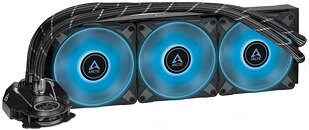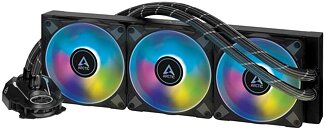Sunday, July 11th 2021

ARCTIC Announces Liquid Freezer II 360 RGB/A-RGB Coolers
ARCTIC, one of the leading manufacturers of low-noise PC coolers and components, recently added lighting options to its popular water cooling series with the Liquid Freezer II 240 RGB & A-RGB. Now, the A-/RGB portfolio continues to grow with the Liquid Freezer II 360 also becoming available in two LED variants. The three fans of the powerful 360 variant are each equipped with twelve RGB LEDs. While the Liquid Freezer II 360 RGB provides systems with a rich, even glow, the Liquid Freezer II 360 A-RGB gives users even more comprehensive lighting options. Autonomously controllable RGB LEDs allow for a bespoke color experience with an almost infinitely customizable variety of effects.
Well-known and distinctive series features, such as a premium-class radiator, the PWM-controlled pump, and a 40-millimeter VRM cooling fan ensure the ideal balance of high performance and low noise. Fully encased hoses and a well-thought-out cable management system round out the no-fuss, all-in-one solutions.Pricing & Availability
Source:
ARCTIC
Well-known and distinctive series features, such as a premium-class radiator, the PWM-controlled pump, and a 40-millimeter VRM cooling fan ensure the ideal balance of high performance and low noise. Fully encased hoses and a well-thought-out cable management system round out the no-fuss, all-in-one solutions.Pricing & Availability
- The ARCTIC Liquid Freezer II 360 RGB is available now on Amazon at a starting price of 146.80 USD.
- The ARCTIC Liquid Freezer II 360 A-RGB is available now on Amazon at a starting price of 153.13 USD.


18 Comments on ARCTIC Announces Liquid Freezer II 360 RGB/A-RGB Coolers
I've used both the 240 and 360 AIO, and I am happy with its performance and noise level. Compared to the Corsair H100i Pro which sounded like a leaf blower with its crappy ML fans and very loud pump, with bad thermal performance, I would happily recommend the Arctic Liquid Freezer II. But do note the mount on certain versions may be obstructed on certain motherboards, depending on the layout of the motherboard. For example, I wasn't able to use the AMD AM4 offset mount position as it was obstructed. Even the normal mounting position was a very tight fit.
In addition, I have no idea how you have mounted the radiator, so I can't really tell if that is the cause of poor thermals. Based on my latest Arctic Freezer II 240, I noticed that there is a lot of slushing sound when I shake it. What that tells me is that the fluid level is not very high, which means if you were to say bottom mount the radiator, it is possible that your cooling will be really poor.
In case you've never saw and considered this:
That is not a low wattage chip by any means
its a 200-300W chip depending on BIOS settings (which vary a LOT between boards)
AMD is low wattage(and hard to cool, needing quality contact especially), intel is easy to cool (but needs big coolers) - i wouldnt even want a 240mm AIO on modern intel
Also, please define "thermal throttling". Technically, it's only thermal throttling if it's going below base clocks, i.e. below 3.6GHz. If it's above that, it's just not boosting as much. It's only rated to sustain 3.6GHz at 125W - though to be honest, even that would be pushing it for even a good 120mm AIO. If it's hitting 100°C and dropping below 3.6GHz, then it's thermal throttling, but if not, it isn't. To sustain 5GHz or close to it, the CPU needs 170-225W, and there is no way on earth a 120mm AIO is capable of cooling a thermally dense CPU outputting that kind fo heat.
As for AIOs in general, Arctic and EK makes the best ones available today, and Arctic wins in terms of combined performance and noise (EK's fans are rather noisy at high speeds). Everyone else is a clear step behind. (Except possibly Alphacool, though their AIOs are more like pre-assembled custom loops.)
if a Noctua NH-U14S can cool this cpu at stock so should the Arctic liquid freezer II 120
157 x 120 x 38 for the AF II, with 932g weight including all the other stuff- coolant, hoses, pump, fan, etc.
The U14-S is 165 x 150 x 78, at 935g (with fan)
Now without someone ripping apart their AFII 120mm i cant get a direct weight of the radiator alone, but that info above really does show the U14S has a lot more heatsink to it, and for intels 125W (really, 220W-300W) part you NEED that mass to cool it.
The motherboard and its settings control how much wattage is thrown out in the boost periods and for how long, and you can simply lower those numbers to reduce the heat, and the performance.
With that tiny ass 120mm AIO, you're gunna need to run at the advertised stock 125W, which is locked to 3.6GHz
Edit: typo — is it just me or does this editor sometimes randomly add words when typing?